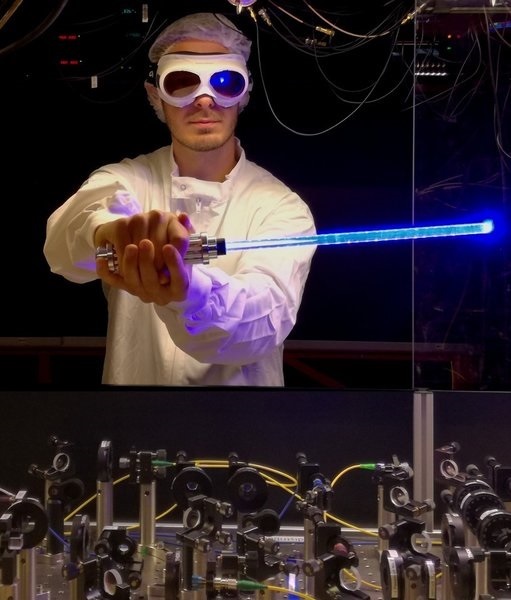June 19, 2018
Who would not want to have a light saber? While the idea from science fiction has sparked our imagination, technical realization of this fantasy is elusive, since photons, the particles that make up light, do not interact. Already from everyday experience, we know that two light beams, whether radiation of traditional lamps or laser beams, pass each other undisturbed. However, this same quality makes photons useful as stable carriers of quantum information for quantum communication and computing. On the other hand, processing of the quantum information again requires controlled interactions between photons at so-called quantum nodes that carry out computations.
Physicists at the Max-Planck Institute of Quantum Optics have now demonstrated such a controlled interaction between light beams of different color at the level of single photons. Making use of a single atom in an optical cavity, they observed two regimes in which the fields either block each other or only transit the system conjunctively. As a first immediate application, they show an optical switch where one beam turns off the other.
Though particles, photons exhibit neither mass nor charge. As a consequence they do not interact with each other. Their electric field, however, causes them to interact with charged particles in matter. In case this interaction is nonlinear and sufficiently strong, it may in turn be used to mediate interactions between photons. The probably most dramatic effect is observed for a single atom with only two levels, excited and ground state: absorption of a first photon would turn the absorber into an emitter and, therefore, a second photon is transmitted depending on the presence of that prior photon.
A major challenge over the past 30 years has been to make the corresponding interaction probability, negligible for a single atom in free space, large. Placing the atom between two high-quality mirrors that cause the photon to pass the atom repeatedly and confine it to a small volume at its location, was demonstrated to yield strong single-photon interaction. However, its effect is mostly observed on the photon statistics, as long as it only mediates interactions between indistinguishable photons of a single beam. Examples are single- and two-photon blockade. Bringing a second light field into the cavity formed by the mirrors and finding a suitable energy level structure, it is possible to implement interactions between distinguishable photons of different color. While technically challenging, Christoph Hamsen and co-workers realized a so-called N-type system and observe novel effects of mutual blocking and conjunct transit where photons of the different fields either block each other or only transit the system together. Employing the regime of blockade, they demonstrate an optical switch where each field may toggle the other one ON or OFF.
These effects stem from the novel energy level structure for the joint system that is formed by the strong coupling between the two light fields and the atom. In this level scheme, each selectively-addressable state reflects a specific number of photons in each of the two fields which correlates their number in both beams.
While light sabers remain elusive, the new system displays coherent interaction and forms a new doubly nonlinear level scheme that opens the route towards quantum nonlinear sensing where the number of photons in one beam may measure the number of photons in the other.
Original publication:
Christoph Hamsen, Karl Nicolas Tolazzi, Tatjana Wilk, and Gerhard Rempe
Strong coupling between photons of two light fields mediated by one atom
Nature Physics, http://dx.doi.org/10.1038/s41567-018-0181-1















